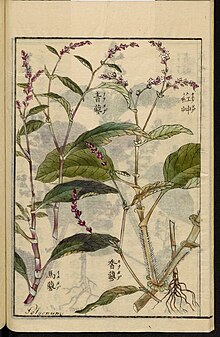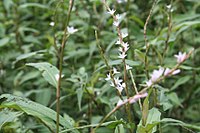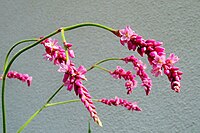Persicaria
| Persicaria | |
|---|---|

| |
| Persicaria capitata | |
| Scientific classification | |
| Kingdom: | Plantae |
| Clade: | Tracheophytes |
| Clade: | Angiosperms |
| Clade: | Eudicots |
| Order: | Caryophyllales |
| Family: | Polygonaceae |
| Subfamily: | Polygonoideae |
| Genus: | Persicaria Mill. 1754 |
| Species | |
|
See text | |
| Synonyms[1] | |
|
List
| |

Persicaria is a genus of herbaceous flowering plants in the knotweed family, Polygonaceae. Plants of the genus are known commonly as knotweeds[2]: 436 or smartweeds.[3] It has a cosmopolitan distribution, with species occurring nearly worldwide.[3][4] The genus was segregated from Polygonum.[5]
Description
[edit]The genus includes annual and perennial herbs with taproots or fibrous root systems, or with rhizomes or stolons. The stems are often erect but may be prostrate along the ground, and some species are prickly.[3] The stems are self-supporting or twining and climbing.[6] The leaves are alternately arranged, deciduous, and variously shaped. The brownish or reddish ochrea may be leathery to papery. The inflorescence may be a panicle or a spikelike or headlike arrangement of fascicles of flowers. The flower is white, greenish, reddish, pink or purple, with the tepals partially fused together along the bases. The fruit is an achene which can take a number of shapes, including a disc or a sphere.[3]
Taxonomy
[edit]Within the family Polygonaceae, Persicaria is placed in the subfamily Polygonoideae, where the tribe Persicarieae consists of two sister genera, Bistorta and Koenigia, together with Persicaria.[7]
| Persicarieae |
| ||||||||||||
Species
[edit]As of November 2023[update], the following 132 species were accepted:[8]
- Persicaria acuminata (Kunth) M.Gómez
- Persicaria akakiensis (Cufod.) Soják
- Persicaria × ambigua (Meisn.) B.Bock
- Persicaria amphibia (L.) Delarbre – amphibious bistort, water smartweed
- Persicaria angustifolia (Pall.) Ronse Decr.
- Persicaria arifolia (L.) Haraldson – halberd-leaf tearthumb
- Persicaria assamica (Meisn.) Soják
- Persicaria attenuata (R.Br.) Soják
- Persicaria barbata (L.) H.Hara
- Persicaria × bicolor (Borbás) Soják
- Persicaria biconvexa (Hayata) Nemoto
- Persicaria bicornis (Raf.) Nieuwl. – pink smartweed
- Persicaria borneensis (Meisn.) Soják
- Persicaria × brauniana (F.W.Schultz) Soják
- Persicaria breviochreata (Makino) Ohki
- Persicaria bungeana (Turcz.) Nakai – prickly smartweed
- Persicaria capitata (Buch.-Ham. ex D.Don) H.Gross – pink-head knotweed
- Persicaria careyi (Olney) Greene – pink-head knotweed
- Persicaria celebica (Danser) Soják
- Persicaria cespitosa (Blume) Nakai
- Persicaria changhuaensis H.W.Zhang & X.F.Jin
- Persicaria chinensis (L.) H.Gross – Chinese knotweed
- Persicaria clivorum Seriz.
- Persicaria × condensata (F.W.Schultz) Soják
- Persicaria criopolitana (Hance) Migo
- Persicaria debilis (Meisn.) H.Gross ex W.Lee
- Persicaria decipiens (R.Br.) K.L.Wilson – slender knotweed, willow-weed
- Persicaria dichotoma (Blume) Masam.
- Persicaria diospyrifolia (Cham. & Schltdl.) Funez & Hassemer
- Persicaria dissitiflora (Hemsl.) H.Gross ex T.Mori
- Persicaria eciliata M.A.Hassan
- Persicaria elatior (R.Br.) Soják
- Persicaria erectominor (Makino) Nakai
- Persicaria extremiorientalis (Vorosch.) Tzvelev
- Persicaria ferruginea (Wedd.) Soják
- Persicaria × figertii (Beck) Soják
- Persicaria filiformis (Thunb.) Nakai
- Persicaria foliosa (H.Lindb.) Kitag.
- Persicaria galapagensis (Caruel) Galasso
- Persicaria geocarpica Suyama & K.Ueda
- Persicaria glabra (Willd.) M.Gómez – smooth smartweed
- Persicaria glacialis (Meisn.) H.Hara
- Persicaria glandulopilosa (De Wild.) Soják
- Persicaria glomerata (Dammer) S.Ortiz & Paiva
- Persicaria greuteriana Galasso
- Persicaria hassegawae Hanai & Seriz.
- Persicaria hastatosagittata (Makino) Nakai
- Persicaria × hervieri (Beck) Soják
- Persicaria hirsuta (Walter) Small – hairy smartweed
- Persicaria hispida (Kunth) M.Gómez
- Persicaria huananensis (A.J.Li) B.Li
- Persicaria humboldtiana Funez & Hassemer
- Persicaria humilis (Meisn.) H.Hara
- Persicaria × hybrida (Chaub. ex St.-Amans) Soják
- Persicaria hydropiper (L.) Delarbre – water-pepper, marsh-pepper smartweed
- Persicaria hydropiperoides (Michx.) Small – swamp smartweed, mild water-pepper
- Persicaria hystricula (J.Schust.) Soják
- Persicaria imeretina (Kom.) Soják
- Persicaria × intercedens (Beck) Soják
- Persicaria japonica (Meisn.) Nakai
- Persicaria javanica (Bruyn) Soják
- Persicaria jucunda (Meisn.) Migo
- Persicaria kawagoeana (Makino) Nakai
- Persicaria lanata (Roxb.) Tzvelev
- Persicaria lankeshanensis T.J.Liang & Bo Li
- Persicaria lapathifolia (L.) Delarbre – pale persicaria
- Persicaria leblebicii (Yıld.) Raus
- Persicaria lii Kitag.
- Persicaria limbata (Meisn.) H.Hara
- Persicaria limicola (Sam.) Yonek. & H.Ohashi
- Persicaria longiflora (Courchet) Borodina
- Persicaria longiseta (Bruijn) Kitag. – bristly lady's thumb
- Persicaria maackiana (Regel) Nakai
- Persicaria macrantha (Meisn.) Haraldson
- Persicaria maculosa Gray – Jesusplant, spotted lady's thumb, redshank
- Persicaria madagascariensis (Meisn.) S.Ortiz & Paiva
- Persicaria manshuricola Kitag.
- Persicaria meisneriana (Cham. & Schltdl.) M.Gómez – Mexican tearthumb
- Persicaria microcephala (D.Don) H.Gross
- Persicaria mikawana Hanai & Seriz.
- Persicaria minor (Huds.) Opiz – small water-pepper
- Persicaria mitis (Schrank) Assenov
- Persicaria muricata (Meisn.) Nemoto
- Persicaria × musashinoensis Hiyama
- Persicaria nakaii (H.Hara) Cubey
- Persicaria nataliae Stepanov
- Persicaria neofiliformis (Nakai) Ohki
- Persicaria nepalensis (Meisn.) H.Gross – Nepal knotweed
- Persicaria nogueirae S.Ortiz & Paiva
- Persicaria obtusifolia (Täckh. & Boulos) Greuter & Burdet
- Persicaria odorata (Lour.) Soják – Vietnamese coriander
- Persicaria orientalis (L.) Spach – kiss-me-over-the-garden-gate, prince's feather, princess-feather
- Persicaria palmata (Dunn) Yonek. & H.Ohashi
- Persicaria paradoxa (H.Lév.) Kantachot
- Persicaria paraguayensis (Wedd.) S.T.Kim & Donoghue
- Persicaria paralimicola (A.J.Li) B.Li
- Persicaria pensylvanica (L.) M.Gómez – Pennsylvania smartweed
- Persicaria perfoliata (L.) H.Gross
- Persicaria peruviana (Meisn.) Soják
- Persicaria pilushanensis (Y.C.Liu & C.H.Ou) C.F.Kuo ex T.C.Hsu & S.W.Chung
- Persicaria pinetorum (Hemsl.) H.Gross
- Persicaria poiretii (Meisn.) K.L.Wilson
- Persicaria posumbu (Buch.-Ham. ex D.Don) H.Gross
- Persicaria praetermissa (Hook.f.) H.Hara
- Persicaria prostrata (R.Br.) Soják - creeping knotweed
- Persicaria × pseudoincana (Klokov) Doweld
- Persicaria × pseudolapathum (Schur) D.H.Kent
- Persicaria pubescens (Blume) H.Hara
- Persicaria pulchra Soják
- Persicaria punctata (Elliott) Small – dotted knotweed
- Persicaria puritanorum (Fernald) Soják
- Persicaria robustior (Small) E.P.Bicknell – stout smartweed
- Persicaria rotunda (Z.Z.Zhou & Q.Y.Sun) Bo Li
- Persicaria rubricaulis (Cham.) Galasso
- Persicaria runcinata (Buch.-Ham. ex D.Don) H.Gross
- Persicaria sagittata (L.) H.Gross – American tearthumb, arrowleaf tearthumb, arrowvine
- Persicaria sagittifolia H.Gross
- Persicaria segetum (Kunth) Small
- Persicaria senegalensis (Meisn.) Soják
- Persicaria senticosa (Meisn.) H.Gross
- Persicaria setacea (Baldwin) Small – bog smartweed
- Persicaria setosula (A.Rich.) K.L.Wilson
- Persicaria sinica Migo
- Persicaria sinuata (Royle ex Bab.) H.Gross
- Persicaria snobarii Munshi & Javeid
- Persicaria stagnina (Buch.-Ham. ex Meisn.) M.A.Hassan
- Persicaria stelligera (Cham.) Galasso
- Persicaria strigosa (R.Br.) H.Gross – spotted knotweed
- Persicaria strindbergii (J.Schust.) Galasso
- Persicaria subsessilis (R.Br.) K.L.Wilson
- Persicaria sylvestris Funez & Hassemer
- Persicaria taitoinsularis (Masam.) Yonek.
- Persicaria taquetii (H.Lév.) Koidz.
- Persicaria thunbergii (Siebold & Zucc.) H.Gross
- Persicaria tinctoria (Aiton) Spach – Chinese indigo, polygonum-indigo
- Persicaria tomentosa (Schrank) E.P.Bicknell
- Persicaria trigonocarpa (Makino) Nakai
- Persicaria umbrosa (Sam.) Galasso
- Persicaria virginiana (L.) Gaertn. – jumpseed
- Persicaria viscofera (Makino) H.Gross
- Persicaria viscosa (Buch.-Ham. ex D.Don) H.Gross ex T.Mori
- Persicaria wellensii (De Wild.) Soják
- Persicaria × wilmsii (Beck) Soják
- Persicaria wugongshanensis Bo Li
Citations
[edit]- ^ "Persicaria Mill". Plants of the World Online. Board of Trustees of the Royal Botanic Gardens, Kew. 2017. Retrieved 17 September 2020.
- ^ Stace, C. A. (2010). New Flora of the British Isles (Third ed.). Cambridge, U.K.: Cambridge University Press. p. 88. ISBN 9780521707725.
- ^ a b c d Persicaria. Flora of North America.
- ^ Persicaria. New South Wales Flora Online. National Herbarium, Royal Botanic Garden, Sydney.
- ^ Wilson, K. L. (1990). "Some widespread species of Persicaria (Polygonaceae) and their allies". Kew Bulletin 45(4) 621-36.
- ^ Persicaria. FloraBase. Western Australian Herbarium.
- ^ Schuster et al 2015.
- ^ "Persicaria Mill". Plants of the World Online. Royal Botanic Gardens, Kew. Retrieved 2023-11-08.
General and cited references
[edit]- Schuster, Tanja M.; Reveal, James L.; Bayly, Michael J. & Kron, Kathleen A. (2015). "An updated molecular phylogeny of Polygonoideae (Polygonaceae): Relationships of Oxygonum, Pteroxygonum, and Rumex, and a new circumscription of Koenigia". Taxon. 64 (6): 1188–1208. doi:10.12705/646.5.





